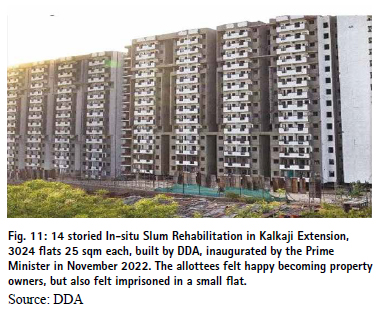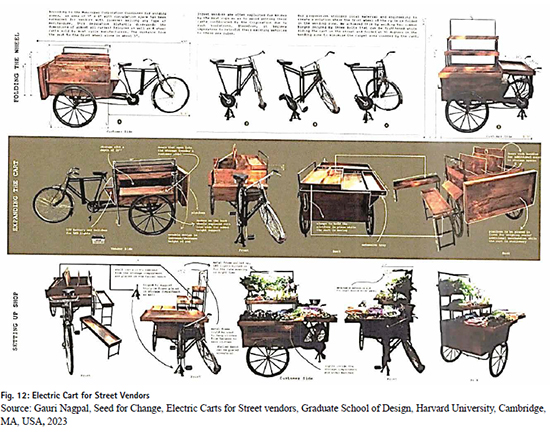| GIS | |
Empowering the poor by slum and squatter resettlement in Delhi
Urban policies, resettlement and low-cost housing are the powerful tools of the poverty reduction which transform the lives of the poor |
 |
|
During 1975-77, a massive program of slum resettlement, covering 7 lakh people living in the slums and JhuggiJhompri (JJ) clusters was undertaken in Delhi. The Delhi Development Authority (DDA) developed 1,54,000 plots of 25 square yard (21 sqm) in 27 resettlement colonies for the slum dwellers (Figs. 1 to 5). Touted as one of the world’s largest slum resettlement projects, it created controversies, such as forced evictions, whether the slums are a problem or a solution and disconnecting the poor from their livelihoods. It was a hot topic of discussion at the UN Conference on Human Settlements and Habitat Forum held in 1976 at Vancouver, Canada, which was attended by the heads of various governments (UN Member countries), delegates from professional and academic institutions, NGOs and the author (A.K. Jain).
The Union Minister of Works and Housing presented India’s Country Report, highlighting various policies and schemes of urban development and housing, the establishment of the Delhi Development Authority (DDA) and formulation of Delhi Master Plan. He was followed by Jagmohan, the Vice Chairman of the DDA, and the architect of Delhi Master Plan and slum resettlement policy of Delhi. He forcefully defended the Resettlement Schemes, which not only aimed at making Delhi slum free, but also to serve the poorest of poor families to own a house. He mentioned that about 1000 Ha of DDA land was developed with site and services and allotted to the slum dwellers and squatters almost free of cost as an endeavour of equitable development.
However, the critics continued raising the questions of forced evictions, political aspirations, misplaced notions of beautifying the city, poor infrastructure services, disconnect with the livelihoods, entrenched poverty, fragmented environment and asymmetrical societies. It was alleged that the hutment dwellers immediately sell the land allotted by the DDA and squat again somewhere else. However, the surveys did not confirm this, except one-third of the resettlement plots were sold unauthorisedly (which also happens in posh colonies like Vasant Vihar). John Turner went to the extent of saying that the perception of the governments and planners has to change as the slums are not a problem but a solution. Some speakers underlined the issues of corruption, non-participatory decision making and top-heavy planning. Keenly listening the criticism, it was my turn to speak.


I pointed out that sitting in Vancouver, it is difficult to visualise the reality of the hutment dwellers in India who are pushed out from their homelands and come to a big city like Delhi, just to survive and look for roti, kapda and makaan (bread, clothing and shelter). In order to survive, they work as the casual labours, rickshaw pullers, loaders, beggars, street vendors and domestic help. They seek shelter in the hutments, sharing the room with other 2 to 4 persons and pay for sleeping. It may be Rs 20 to 40 per night, per bed, but could be Rs 30 to 50 with electricity (a fan and tube light). These kind of the shacks are often put on government land by ‘slum landlords’ having political patronage as their names would suggest (Arjun DasSonia, Sanjay, Rajiv, Nehru, Gandhi camp, etc.). Under hand to mouth conditions, they could never imagine owning a house, or sending their children to a school, condemning even their next generation.
Slum eviction and resettlement are the painful processes, even more so by intimidating, police like attitude of the authorities. However, this is not the end, but with better communications, empathy and compassion the pain of eviction and relocation can be mitigated. Most of the slum dwellers are aware of the value of shelter which could catapult them and their children out of the cycle of poverty and perpetual suffering.

They need support from the planning and housing agencies, both governmental and non-governmental, to enable them to always put the last person first, looking at the hutment dweller, the informal sector hawker, the physically challenged, domestic servants, rickshawalas, and casual workers. This requires seeking the paths and channels to support, facilitate and empower the poor citizens into becoming its stakeholders, thus harnessing their energies and amplifying their contribution. We need to examine the shelter, in a milieu where planning has safeguarded disproportionately for the elite segments of the society.
Urban policies, resettlement and lowcost housing are the powerful tools of the poverty reduction which transform the lives of the poor and their children. As suggested by Jane Jacob, Hernando de Sato and Graham Tipple, the small shops and micro- businesses are the symptoms of inclusive growth and empowered informal sector, which should be encouraged in resettlement schemes rather than being controlled.
The greatest advantage of the site and services strategy is that it is rapid, low cost and provides freedom to the families to design their dwellings according to their needs, resources and tastes. The allottees finance the cost of constructing their houses and part of the land cost, whereas the development agency provides the land and services. This way every house is an expression of the lifestyle of its dwellers, but within an organised framework. In Delhi, Site and Services model provided plots with water tap, toilet and bathing space whereas the owners could add the kitchen and more rooms.
My presentation was heard with keen interest. Although, I was not part of the official delegation, the Vice Chairman, DDA said that he feels that I have replied to most of the queries of the critics. After returning, I joined the DDA as Associate Planner. Besides other tasks, my duty was to brief and show the resettlement and other schemes to the important visitors, which included the officials from the UN, World Bank, ADB, media, professionals, NGOs, etc. Most of the visitors initially had a critical opinion about the resettlement schemes, but after the visit and briefing many of them gave constructive and encouraging suggestions.


Keeping in view the feedback the policy of Slums and JJ Resettlement was amended towards in-situ and collective rehabilitation with a more active participation of the families and slum cooperatives (Fig. 5). Accordingly, the Master Plan of Delhi 2021 mandated that the existing resettlement colonies be upgraded and redeveloped, and reserve 15% of bonus Floor Area Ratio for LIG/EWS housing in all new housing schemes (Fig. 6). The community formation should be the basis of spatial organisation. The layout should allow evolutionary and participatory housing and infrastructure development.
Based on self-help, the simple, local concepts of construction can be promoted, as adopted by Laurie Baker. The principle of incremental housing can be developed with locally produced precast elements and components (Figs 7 to 10). The service cores and slots on alternate streets allow upgradation of the services, while the construction is done with simple and locally available materials. For quick and low-cost resettlement, skeleton housing clusters can be created which define a framework for construction of the dwellings by the residents themselves according to their needs and resources. Simple prefab elements- columns, beams, floor, roof tiles can be made available at the site for construction around a wet core.

The variety of slum and squatter settlements need differential approaches rather than a single approach. This involves redefining the space standards for shelter, greens, play area, social infrastructure, transport and utilities. Slum rehabilitation in multi-storied apartments converts a house into a commodity and eschews participatory approaches (Fig. 11). On the contrary, Site and Services Resettlement helps in synchronising poverty reduction, livelihoods, community engagement and gender equity

For most of the slum dwellers, livelihood is a major issue. 10% of the space in all shopping centres should be reserved for street vendors and informal traders. Electric handcarts for fruits and vegetable vendors can be designed with better storage and services (Fig. 12).

Slums are inevitable products of urban development. No word suggests more terrible image of the poor man’s life. No word is more capable of rousing people to protest and shock the politicians’ conscience. The challenge and litmus test of urban planning lies in addressing the issues of slums and squatter settlements.
References
ADB and CRISIL, Strategic Framework for a Slum Free Delhi, DUSIB, GNCTD, New Delhi, 2013
Ali, Sabir, Environment and Resettlement Colonies of Delhi, Har Anand Publications, New Delhi, 1995
Christopher Benninger, Architecture for Modern India, India House, Pune, 2015
Delhi Development Authority, Master Plans for Delhi, DDA, New Delhi, 1962, 2001 and 2021
Deependra Prasad, New Architecture and Urbanism, INTBAU, New Delhi,.2006
Dupont, Veronique, Emma Tarlo, Denis Vidal Delhi Urban Space and Human Destinies, Manohar, New Delhi, 2000
Gauri Nagpal, Seed for Change, Electric Carts for Street vendors, Graduate School of Design, Harvard University, Cambridge, MA, USA, 2023
Gupta R.G., Shelter for the Poor in Fourth World, Vols. 1 &II, Shipra, New Delhi, 1995
Jagmohan, Island of Truth, New Delhi: Vikas Publishing House, 1978.
Jain A.K. The Informal City, Readworthy, New Delhi, 2011
Jain A.K. Building Systems for Low Income Housing, J.M. Jaina, New Delhi, 2006
Jain, A.K., Transforming Delhi, Bookwell, New Delhi, 2015
Jain A.K., Housing and Community Planning, Discovery Publishing House, New Delhi, 2020
Jain A.K., Mapping Delhi: Past, Present and Future, Synergy Books, New Delhi, 2025
Mishra, Girish, Resettlement Policy of Delhi, IIPA, New Delhi, 1981
Planning Department, GNCTD, Discussion Paper on JhuggiJhompri Clusters and Slum Improvement in the National Capital Territory of Delhi, GNCTD, 1999
Riberio, E.F.N, Shelter Types and Possible Approaches, AMDA, New Delhi, 2000
Town Planning Organisation, Draft Master Plan for Delhi, Government of India, 1959 Turner, John, Housing by People, Towards Autonomy in Building, Marion Boyars Publication, London, 1976
UN Habitat, The Challenges of Slums, Earthscan, London, 2003.

